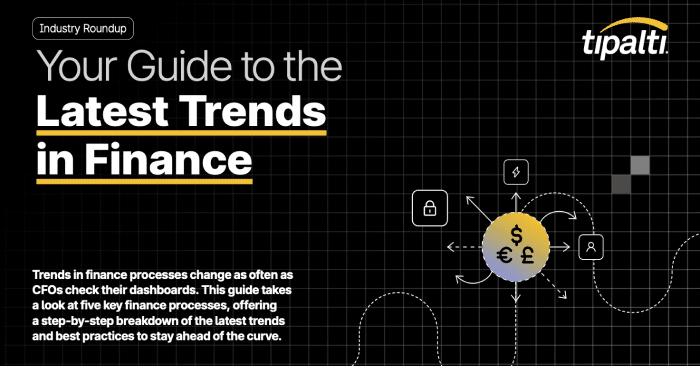
Finance trends shift fast—explore 5 key processes & tips to stay ahead.
Fill out the form to get your free eBook.

Trends in finance processes change as often as CFOs check their dashboards. This guide takes a look at five key finance processes, offering a step-by-step breakdown of the latest trends and best practices to stay ahead of the curve.
Every company knows the struggle of scaling across borders all too well: international expansion intensifies regulatory, fraud, and operational risks, and pushes finance teams to their limits.
That’s why compliance has become a strategic imperative—one that’s evolving faster than finance teams can keep up with. Our global survey of finance professionals across North America and Europe shows just how urgent this is: 50% of respondents report lacking a clear roadmap for managing global compliance.
34% note that changes in economic and governmental policies have added volatility to financial forecasts. International expansion, economic sanctions, changing tariffs, and evolving regulations are driving compliance risks upward, with 43% of respondents experiencing more errors or compliance issues than in previous years.
In short, the results send a clear message: compliance is becoming more difficult, pressing, and essential to business success.
36% of Finance Teams Are Slowed Down Primarily by Resolving Errors
The consequences of operational inefficiency extend beyond frustration; they pose tangible risks to the business. When processes falter, the impact is immediate.
Mid-market companies report higher incidences of these issues, with employees noting that compliance challenges and operational mistakes are increasingly difficult to manage.
In fact, three in five finance professionals agree that fraud is a growing concern across AP processes, and one in four cite that it’s harder than ever to control its impact. What’s more, mid-market finance teams are 48% more likely than SMBs to feel this pressure.
Chasing down mistakes drains resources, distracts teams from higher-value work, and makes staying compliant feel like a constant struggle.
51% Have Invested in Technology, But Gaps Remain
Many finance teams are taking matters into their own hands. 51% of respondents say they’ve invested in technology to improve compliance and control, 43% have implemented new internal protocols, and 33% have increased staffing or added compliance-focused roles.
Even still, the data makes clear that technology and headcount alone are insufficient.
80% of respondents say access to the right tools is essential, and 59% emphasize the need to hire more people.
The truth of the matter is that ad hoc automation or reactive troubleshooting is insufficient and not scalable. Finance operations that keep pace with growth demand systematic automation.
The Case for Systematic Financial Automation
Data shows that teams with fully automated AP processes see clear gains in compliance, tax, and risk management.
For instance, among teams that have fully automated AP, 32% report improved regulatory compliance, with another 32% seeing gains in tax compliance.
Alongside automation, AI adoption is proving its worth, too. 44% of teams are using it for fraud detection and risk monitoring, and another 44% leverage it for data security and privacy purposes.
The Bottom Line: Compliance Is No Longer Optional
Despite the clear benefits, full AP automation remains the exception rather than the rule. Most finance teams are still relying on manual or patchwork processes, which leaves them exposed to errors, compliance gaps, and fraud risk.
On the other hand, the teams that have fully automated processes are already seeing measurable improvements in regulatory and tax compliance. The difference is clear: automation separates teams that stay ahead from those constantly firefighting.
Next Steps: What to Seek in an Automation Platform
The key takeaway is clear: To achieve scalable growth, organizations must move beyond manual, patchwork processes and immediately embrace systematic financial automation. This demands a shift toward strategic, long-term solutions to navigate the rapidly evolving regulatory landscape.
Rather than investing in tactical, short-term fixes, prioritize intelligent, AI-powered systems that offer a unified approach to global financial operations.
To that end, here are a few critical capabilities to look out for when evaluating your next steps:
- Establish Automated Global Compliance for Payables: Look for a unified system with a self-service vendor portal that automates data collection. An ideal platform should automatically validate payee information and manage multi-jurisdictional tax forms (e.g., W-9s and W-8s) before payment.
- Leverage Intelligent Systems for Proactive Fraud Detection: Adopt next-generation solutions that utilize AI and machine learning to analyze transaction patterns. Above all, the system should automatically screen all vendors against national and international fraud and regulatory blacklists to proactively block high-risk activity.
- Demand Consolidated Global Visibility and Control: Select an automation platform that acts as a single, centralized source of truth for all payment activity. This platform must enforce robust internal controls via customizable approval workflows and maintain a detailed, time-stamped audit trail.
- Unify Spend Beyond Traditional Accounts Payable: Prioritize solutions that integrate core financial functions like AP, procurement, and expense management. A unified platform eliminates data silos, ensures process consistency across multiple entities, and empowers your team with real-time, comprehensive spend data.
Ready to see how your finance team stacks up against global peers?
Explore the latest insights from over 2,300 finance professionals worldwide.
